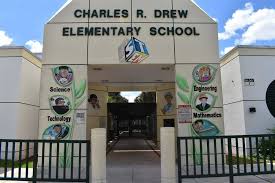How Progress Learning Supports Holley-Navarre Middle School in Florida
At Holley-Navarre Middle School in Florida, educators are seeing transformative growth in their students thanks to Progress Learning. Assistant Principal Pete Della Ratta couldn’t contain his enthusiasm when he described Progress Learning as “the best thing in all my 20 years of being in Santa Rosa County Schools.” He added that it helps “the students and especially parents so the accountability falls on the students to do the work and it allows the teacher more autonomy to work within the subject matter.”
We wanted to hear more about what’s going on at Holley-Navarre so we sat down with Mr. Della Ratta and four educators to hear how Progress Learning has transformed their teaching. Here’s what they had to say…
Saving Teachers Time
A common theme we heard from the educators at Holley-Navarre was that Progress Learning has saved them time and made their jobs easier. Mr. Della Ratta first saw a demo of Progress Learning at the ISTE Conference, and when he saw that the program could improve time management for teachers, he was immediately sold. As Mr. Della Ratta shared, “Planning period is only so long… A lot of [teachers] are planning at home, on the weekend sometimes.”
With Progress Learning, teachers have more time to actually teach, without causing disruption to their students. “Right now, the longest I’ve gone in a classroom without an interruption is 13 minutes. That’s it,” notes Mr. Della Ratta. “I can get the teachers to manage their time more efficiently by using [Progress Learning].” Speaking about the Progress Learning assessments and assignments, he says, “They don’t have to create it. They can go click, click, click. It’s there.” With Progress Learning in their school, there’s less disruption and more learning, allowing teachers to maximize their time and truly ensure that their students grasp and retain the material.
For Brian Meeker, a 6th grade world history teacher, “Progress Learning is a force multiplier for me.” He explains, “It allows me to take attendance. It allows me to do my preliminary procedures within the first 5 to 10 minutes of class. I’ve got a bell ringer on the board and I don’t have to answer 150 times, ‘What are we doing today?’” With all this time freed up, Mr. Meeker says he can focus on differentiation and remediation. “I can reach the students where they’re at and not have that overwhelmed expression.”
Alma Fowler, a 7th grade language arts teacher, shared that her classroom participates in the Green Dot Challenge, which has not only helped her students prepare for state testing but also freed up time for fun incentives and rewards. “By doing the Green Dot Challenge, we were able to cover all the skills and prepare them for the testing, which gave us enough time to do a fun project during Christmas. We built gingerbread houses because I felt confident that they were ready.” She says that this incentive was something “that the kids really responded well to.”
Preparing for Florida Standardized Testing
Another powerful way teachers have been using Progress Learning is to prepare for Florida standardized assessments, including FAST for math and ELA, the Statewide Science Assessment, and EOC exams.
Mrs. Fowler uses Progress Learning in various ways to prepare students for the ELA FAST. “I’ve used it as a progress monitoring tool, I’ve used it as a diagnostic test to measure where our kids are… Once I gain the results from the diagnostic test, I go in and create my own questions and assign skill levels based on students’ abilities and previous knowledge. Now, I’m using it mainly to prepare them for their standardized assessment, which I really like because the questions and type of questions that you guys have [are] similar to what we’re seeing on our state standardized testing.”
Beyond preparing for the test, Mrs. Fowler also uses the program to enhance her students’ test-taking abilities. “I’ll use reciprocal teaching, where I assign my students a specific role that they have to use as they’re reading Progress Learning. They have to discuss it and explain why they’re choosing the answer using test-taking strategies.”
Mr. Meeker has also found the program helpful for improving test-taking skills. “I’m trying to teach my students that anyone can accidentally guess on a multiple choice question. We approach the [Progress Learning] assessments and we pick the wrong answers first. And then one of the assignments I give them is I want them to tell me why it’s wrong. Because if they can tell me why three out of the four answers are wrong, they’ll be able to identify what makes a wrong answer for that standard.”
Dane Locklin, an 8th grade science teacher, uses Progress Learning to ensure his students succeed on the Statewide Science Assessment, which is given at the end of the 8th grade year. He uses it as a supplement in addition to their textbook to monitor how students are progressing with their standards. He also uses it to create assessments, which he tailors to his students’ specific areas of weakness. “I will give an exam based off a certain domain, then go in and monitor which standards the class in general struggled with and design lessons based upon those deficits. Then, I create another test that focuses on those deficits and watch the growth from the first test to our 3rd, 4th, 5th test.” This strategy gives students multiple opportunities to home in on where they are struggling.
Dan Schmidt, a math teacher, is currently using Progress Learning to get his students ready for the EOC exam in math. He uses the practice EOCs available in Progress Learning, and, similarly to Mr. Locklin, creates multiple assessments to progressively target areas of weaknesses. “The goal is the students take it, we review it to make sure they understand what they did right and what they did wrong, then hit them with another practice test, etc. If anybody is weak in any of the standards at that point, then I can reassign them those standards.”
Closing Learning Gaps
Mrs. Fowler brought up another great tool that has been instrumental in her teaching: Progress Learning reporting. “We have been asked over and over again to focus on closing gaps that we are identifying as a part of our progress monitoring. And one of the questions that I’ve been posing over the years is like, ‘Well, how do we do that?’ Because we don’t have a tool to measure. I mean, we have all of these apps that kind of give us a glimpse.” She says that it wasn’t until they got Progress Learning that they were able to truly pinpoint and address those gaps. “I feel like Progress Learning has enabled us to really quickly assess what those specific gaps are and be able to react to it and start working on it and differentiate.”
Preparing Sub Plans
A bonus of Progress Learning, as Mr. Meeker points out, is that it makes it easy to plan for having a substitute teacher. Instead of painstakingly reconstructing entire lessons, he can effortlessly access and share material. “I can pull up lessons and either have them printed or I can put them into another platform… I don’t have to worry about my sub being a social studies expert or a history expert to bridge any connections in content. I know that the content is there and it’s accessible for them.” This calls back the theme of saving teachers time. By streamlining teaching, including substitute teaching, Progress Learning saves educators time and makes their jobs easier, which in turn, allows them to teach to their students without disruption.
Increasing Student Ownership
Another major theme in our conversation was student ownership. Teachers, and even students, love that they can take ownership of their learning. Through the Study Plan, students get their own study path that’s perfectly tailored to their level. “We have kids that are advanced and they can work on their own path at their own pace,” says Mrs. Fowler. And for students who are struggling, “I can pull those small groups of kids together without really overwhelming everyone with repeating the content that they’ve already answered.” Her students often say, “Mrs. Fowler, I can actually work on it on my own!”
Mr. Locklin, the 8th grade science teacher, has come up with a clever strategy for increasing ownership and encouraging students to take the initiative in their learning. “I assign the Study Plan as extra credit, and they’ll have to get an 80 percent or higher proficiency on whatever standard we have assigned.” He then has the student show them on the computer that they’ve completed their work. “I’ll have kids coming up [saying] ‘I finished my work, can I get the extra credit now? Can I do this Study Plan?’ And I’ve seen students who would normally disengage, put their heads down, go to sleep, start talking, goof off, become a distraction. Instead, now they’re grabbing the computer and they’re finding those areas on their own that they struggle with, and they’re taking the initiative to become better, become more proficient.”
Supporting Parents
A third theme on our call was supporting parents. Mr. Della Ratta often has parents come up to him wondering, how can I help my child? He says the Study Plan is a big part of that. Parents can watch the Study Plan from home and see what their child is working on. He says, “It takes the ‘I don’t know’ out of the equation for the parent.”
Student Feedback
Educators, administrators, and parents aren’t the only ones loving Progress Learning. Students love it, too. Mr. Della Ratta shared, “I had an advanced student who didn’t even know what Progress Learning was at the beginning of the year. I told the parent to come in for a parent-teacher because [the student] was in an advanced math class and they were struggling.” He showed both the parent and student Progress Learning, and the student could not believe it. She even asked Mr. Della Ratta, “Where has this been?”
A second inspiring story he shared was of a student who was getting Ds in 6th grade math. The parent came up to him during a parent-teacher conference and said, ‘Well, I’ll do anything.’” The solution Mr. Della Ratta came up with? He had the student redo all the Progress Learning Study Plan videos for 6th grade math. “So every week, the whole summer, the [student did] every single video in each domain of math. And in 7th grade, [the student] came to me and said, ‘I understand math. It’s really that easy!’” By watching the videos in the Study Plan over just one summer, the student made huge strides in math.
It was such a pleasure chatting with Mr. Della Ratta, Mrs. Fowler, Mr. Locklin, Mr. Meeker, and Mr. Schmidt! We’re so glad to hear how Progress Learning has enhanced and streamlined your instruction. Thank you for trusting us at Holley-Navarre!
Want to streamline your teachers’ time, empower your parents, and help your students succeed? Request your free demo of Progress Learning today! We look forward to showing you around the platform.


